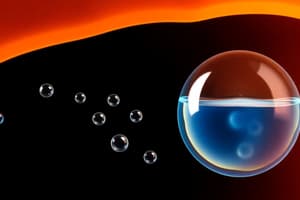Podcast
Questions and Answers
What is the primary source of energy for diffusion?
What is the primary source of energy for diffusion?
- Potential energy stored in chemical bonds
- Heat energy from the environment
- Electrical energy generated by ions
- Kinetic energy from the random movement of molecules (correct)
The surface area to volume ratio increases as a cell becomes larger.
The surface area to volume ratio increases as a cell becomes larger.
False (B)
What is Brownian motion?
What is Brownian motion?
The random movement of particles in a fluid.
Root hair cells in plants are adapted for diffusion by having an increased __________.
Root hair cells in plants are adapted for diffusion by having an increased __________.
Match the following factors with their impact on diffusion:
Match the following factors with their impact on diffusion:
What effect does a smaller distance have on the rate of transport?
What effect does a smaller distance have on the rate of transport?
Higher temperatures result in slower movement of molecules.
Higher temperatures result in slower movement of molecules.
What structural adaptation do blood capillaries and alveoli have to improve diffusion?
What structural adaptation do blood capillaries and alveoli have to improve diffusion?
A greater difference in concentration on either side of the membrane leads to a __________ rate of movement across it.
A greater difference in concentration on either side of the membrane leads to a __________ rate of movement across it.
Match the factors with their effects on the rate of diffusion:
Match the factors with their effects on the rate of diffusion:
What is diffusion in biology?
What is diffusion in biology?
Diffusion does not occur across the cell membrane.
Diffusion does not occur across the cell membrane.
What is a partially permeable membrane?
What is a partially permeable membrane?
Diffusion helps living organisms obtain many of their requirements and get rid of their ______.
Diffusion helps living organisms obtain many of their requirements and get rid of their ______.
Match the following gases with their roles in living organisms:
Match the following gases with their roles in living organisms:
Which factor influences diffusion the most?
Which factor influences diffusion the most?
What happens to plant cells in a dilute solution?
What happens to plant cells in a dilute solution?
Plants only require carbon dioxide for photosynthesis.
Plants only require carbon dioxide for photosynthesis.
Explain what is meant by 'concentration gradient'.
Explain what is meant by 'concentration gradient'.
When plant cells are placed in a concentrated solution, they become turgid.
When plant cells are placed in a concentrated solution, they become turgid.
What term describes plant cells when the cell membrane pulls away from the cell wall?
What term describes plant cells when the cell membrane pulls away from the cell wall?
Plant cells become flaccid when placed in a solution with a lower __________ potential than the cells.
Plant cells become flaccid when placed in a solution with a lower __________ potential than the cells.
Match the following terms with their definitions:
Match the following terms with their definitions:
What is the primary role of water as a solvent in living organisms?
What is the primary role of water as a solvent in living organisms?
Osmosis occurs when water molecules move from a concentrated solution to a dilute solution.
Osmosis occurs when water molecules move from a concentrated solution to a dilute solution.
What is the term for the movement of water molecules through a partially permeable membrane?
What is the term for the movement of water molecules through a partially permeable membrane?
Water plays a crucial role in the ______ reactions in cells.
Water plays a crucial role in the ______ reactions in cells.
Match the following functions with the corresponding substances related to water as a solvent:
Match the following functions with the corresponding substances related to water as a solvent:
Which of the following best describes osmosis?
Which of the following best describes osmosis?
Water is not essential for the transport of substances in organisms.
Water is not essential for the transport of substances in organisms.
Cells are surrounded by a ______ membrane that is partially permeable.
Cells are surrounded by a ______ membrane that is partially permeable.
What is the main reason energy is required for active transport?
What is the main reason energy is required for active transport?
Active transport does not require energy.
Active transport does not require energy.
Name one type of cell that utilizes active transport for glucose uptake.
Name one type of cell that utilizes active transport for glucose uptake.
Active transport is vital for the uptake of _______ from soil water by root hair cells in plants.
Active transport is vital for the uptake of _______ from soil water by root hair cells in plants.
Match the following steps of active transport with their description:
Match the following steps of active transport with their description:
Which of the following processes primarily uses carrier proteins?
Which of the following processes primarily uses carrier proteins?
Carrier proteins require energy from respiration to function.
Carrier proteins require energy from respiration to function.
What is the role of kinetic energy in active transport?
What is the role of kinetic energy in active transport?
Flashcards
Diffusion
Diffusion
The movement of molecules from a region of high concentration to a region of low concentration.
Concentration gradient
Concentration gradient
The difference in concentration of a substance between two regions.
Partially permeable membrane
Partially permeable membrane
A membrane that allows some molecules to pass through but not others.
How does diffusion benefit living organisms?
How does diffusion benefit living organisms?
Signup and view all the flashcards
Examples of diffusion in living organisms
Examples of diffusion in living organisms
Signup and view all the flashcards
What influences the rate of diffusion?
What influences the rate of diffusion?
Signup and view all the flashcards
Why is the cell membrane important for diffusion?
Why is the cell membrane important for diffusion?
Signup and view all the flashcards
What determines what molecules can pass through the cell membrane?
What determines what molecules can pass through the cell membrane?
Signup and view all the flashcards
Brownian motion
Brownian motion
Signup and view all the flashcards
Energy source for diffusion
Energy source for diffusion
Signup and view all the flashcards
Surface area to volume ratio
Surface area to volume ratio
Signup and view all the flashcards
Cell adaptations for diffusion
Cell adaptations for diffusion
Signup and view all the flashcards
Surface Area
Surface Area
Signup and view all the flashcards
Distance
Distance
Signup and view all the flashcards
Temperature
Temperature
Signup and view all the flashcards
Turgid Plant Cell
Turgid Plant Cell
Signup and view all the flashcards
Flaccid Plant Cell
Flaccid Plant Cell
Signup and view all the flashcards
Plasmolysis
Plasmolysis
Signup and view all the flashcards
Water Potential
Water Potential
Signup and view all the flashcards
Osmosis in Plants
Osmosis in Plants
Signup and view all the flashcards
Water as a Solvent
Water as a Solvent
Signup and view all the flashcards
Transport in Organisms
Transport in Organisms
Signup and view all the flashcards
What role does water play in digestion?
What role does water play in digestion?
Signup and view all the flashcards
Water's role in waste removal
Water's role in waste removal
Signup and view all the flashcards
Osmosis
Osmosis
Signup and view all the flashcards
What is the concentration gradient in osmosis?
What is the concentration gradient in osmosis?
Signup and view all the flashcards
Why is osmosis crucial for cells?
Why is osmosis crucial for cells?
Signup and view all the flashcards
Active transport
Active transport
Signup and view all the flashcards
Why is active transport important?
Why is active transport important?
Signup and view all the flashcards
What are carrier proteins?
What are carrier proteins?
Signup and view all the flashcards
How do carrier proteins work in active transport?
How do carrier proteins work in active transport?
Signup and view all the flashcards
Example: Glucose uptake by epithelial cells
Example: Glucose uptake by epithelial cells
Signup and view all the flashcards
Example: Ion uptake by root hair cells
Example: Ion uptake by root hair cells
Signup and view all the flashcards
Active transport vs. diffusion
Active transport vs. diffusion
Signup and view all the flashcards
What does active transport need to work?
What does active transport need to work?
Signup and view all the flashcards
Study Notes
Diffusion in Biology
- Diffusion is the movement of molecules from a region of high concentration to a region of low concentration
- Molecules move down a concentration gradient due to random movement
- The cell membrane is a partially permeable membrane, allowing some molecules to pass through easily while others have difficulty or can't pass through at all
- Diffusion is essential for living organisms to obtain necessary materials and remove waste products
- Examples include: digested food products being absorbed in the small intestine, gases being exchanged in the lungs and leaves, and the absorption of water and mineral ions in root hair cells
Factors influencing Diffusion
- Surface area to volume ratio: smaller surface area to volume ratio means slower diffusion rates. Cells adapted for diffusion have increased surface areas (e.g., root hair cells and cells lining the ileum).
- Distance: shorter distances lead to faster diffusion rates. For example, the thin walls of capillaries and alveoli facilitate rapid diffusion.
- Temperature: higher temperatures increase the kinetic energy of molecules, speeding up diffusion.
- Concentration gradient: the larger the difference in concentration across a membrane, the faster the rate of diffusion.
Water as a Solvent
- Water is a solvent, meaning many substances dissolve in it
- Dissolved substances are easily transported throughout organisms (e.g., xylem and phloem, blood).
- Digested food molecules must dissolve to be transported to all parts of the body.
- Toxins and waste products are dissolved in water for easier removal (e.g., urine).
- Water is essential for metabolic reactions within cells.
Osmosis
- Osmosis is the movement of water molecules from a dilute solution (high water potential) to a concentrated solution (low water potential) across a partially permeable membrane.
- Cell membranes are partially permeable, allowing water molecules to pass through but not larger solute molecules
- Water moves down the water potential gradient
- Osmosis experiments involve immersing plant cells (e.g., potato cylinders) in solutions of different concentrations to observe changes in mass.
- Plant cells placed in a dilute solution will gain water and become turgid.
- Plant cells placed in a concentrated solution will lose water and become plasmolysed.
- Animal cells placed in a dilute solution will swell and potentially burst (lyse)
- Animal cells in a concentrated solution will shrink (crenate)
- Osmosis is important for maintaining cell structure and function in both plant and animal cells
Active Transport
- Active transport moves substances from a region of low concentration to a region of high concentration.
- This process requires energy (from respiration).
- Carrier proteins in the cell membrane are essential for active transport to take place.
- Substances bind to specific carrier proteins, and energy is used to change the shape of the protein and transport the substances across the cell membrane
- This helps living organisms to maintain appropriate concentrations of molecules within cells.
- Examples include uptake of ions in root hair cells, absorption in the villi of the small intestine and removal of waste from the kidney.
Importance of Active Transport
- Active transport is important for maintaining needed concentrations of molecules within the cells.
- Active transport enables plants and animals to absorb nutrients.
- Examples of functions of active transport include reabsorption of glucose and amino acids by kidney tubules, uptake of mineral ions by plants, and absorption of glucose by cells lining the villi in the small intestine
Studying That Suits You
Use AI to generate personalized quizzes and flashcards to suit your learning preferences.




